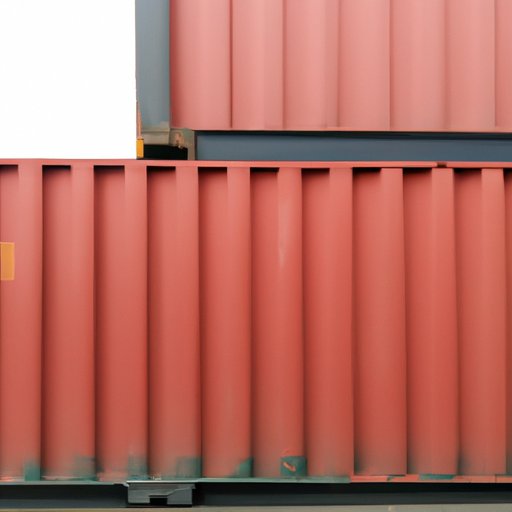
Introduction
As a business owner, you’re likely familiar with the challenges of shipping goods – whether it’s across the country or around the world. But do you know how much a shipping container weighs? This is a crucial piece of information that many business owners often overlook. Understanding the weight of a shipping container can play a significant role in determining shipping costs, as well as ensuring that your cargo arrives safely and securely.

The Ultimate Guide to Shipping Container Weight: How to Calculate it and What it Means for Your Business
Shipping container weight refers to the overall weight of a container, including its cargo. It’s essential to understand the weight of each container before you transport goods to ensure that all safety regulations are met. Calculating container weight is relatively simple – it involves adding the weight of an empty container to the weight of the cargo.
Understanding shipping container weight is essential for businesses because it helps them determine the transport capacity they need. Overloading a container can result in costly fines and damage to the container or goods.
Breaking Down the Numbers: A Look at the Standard Weights of Different Shipping Container Sizes
Shipping containers come in different sizes and weights. Standard shipping containers come in various sizes, including 20-foot, 40-foot, and 45-foot containers. A 20-foot container has a capacity of 33 cubic meters and weighs around 2,300 kg when empty. 40-foot containers weigh around 3,750 kg and have a capacity of 67 cubic meters. 45-foot containers are the largest and weigh approximately 4,500 kg.
The weight capacity of a shipping container varies depending on the cargo. For example, a 20-foot container can typically hold between 28,000-30,000 lbs (12,700-13,600 kg), while a 40-foot container can hold up to 58,000 lbs (26,300 kg) of cargo.
From Empty to Full: Understanding How Cargo Affects Shipping Container Weight
Cargo is the primary factor in determining the weight of a shipping container. Many goods, like food and clothing, are light and don’t weigh very much. On the other hand, items like machinery and raw materials can be extremely heavy.
Understanding the weight of your cargo is essential in determining the transport capacity you need. It’s a good idea to weigh your cargo before shipping to avoid overloading your container and facing fines or damaged goods. You can manage weight based on the cargo being transported by choosing appropriate container sizes and storage requirements.
Shipping Container Weight: Why it Matters and How to Optimize it for Cost Savings
Shipping container weight plays a vital role in determining shipping costs. Overweight containers can lead to additional surcharges and delays, resulting in higher costs. Therefore, it’s essential to optimize shipping container weight to reduce costs. One way to do this is to choose an appropriate container size based on your cargo’s weight and volume.
Another way to optimize the shipping container weight is by using packaging materials that are lightweight and durable, such as recyclable materials. You can also opt for intermodal transport, which involves the use of different transportation modes, such as air, sea, and rail, to reduce transportation costs.
The Surprising Factors That Can Impact Shipping Container Weight and What You Can Do About Them
Several factors can impact shipping container weight unexpectedly. For instance, adverse weather conditions can lead to increased humidity, resulting in water accumulation in containers. This can add extra weight to the cargo, leading to overweight containers. Therefore, it’s essential to consider weather conditions before shipping goods. It’s a good idea to check the weather forecast for your destination and choose appropriate packaging materials.
Another factor that can impact container weight is the quality of packaging materials used. Poor quality packing materials can become wet and heavy, adding extra weight to the container.
Shipping Container Weight Demystified: Everything You Need to Know Before You Buy or Rent
Before buying or renting a shipping container, it’s essential to determine how much weight you need to transport. You should consider the cargo’s weight and volume to ensure you buy or rent the right-sized container. Always check the weight capacity and size of the container carefully before making a decision.
Conclusion
In conclusion, understanding shipping container weight is essential for businesses. It helps determine transport capacity and reduces the risk of overloading containers. It also plays a significant role in determining shipping costs, so optimizing container weight can result in significant cost savings. Remember to consider the weight of your cargo, packaging materials, and weather conditions when shipping goods. By following these tips, you can ensure your cargo arrives safely and securely, while also minimizing shipping costs.





